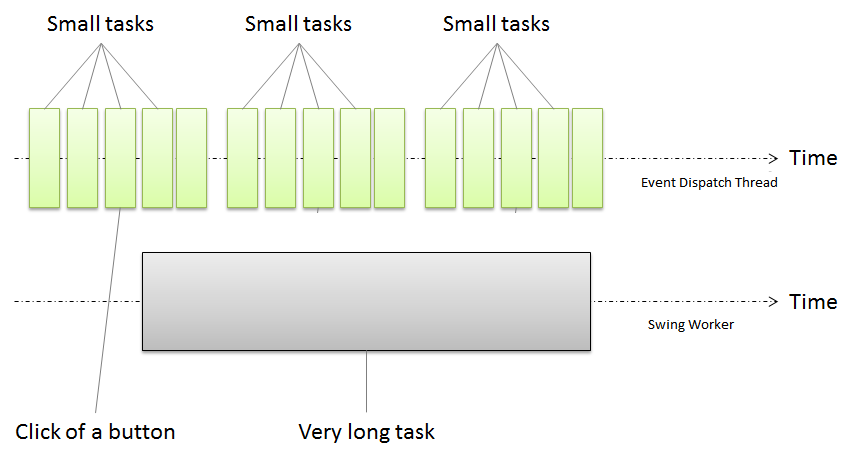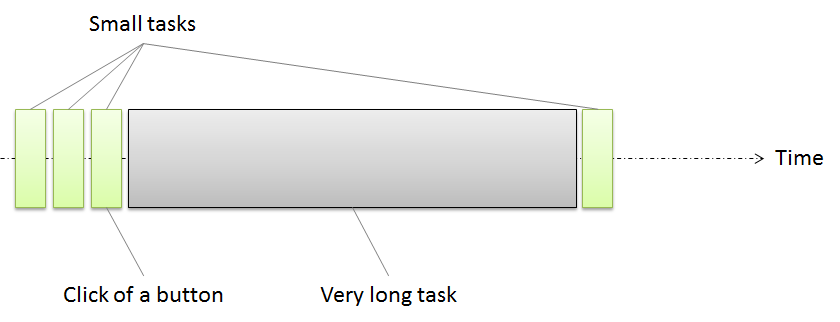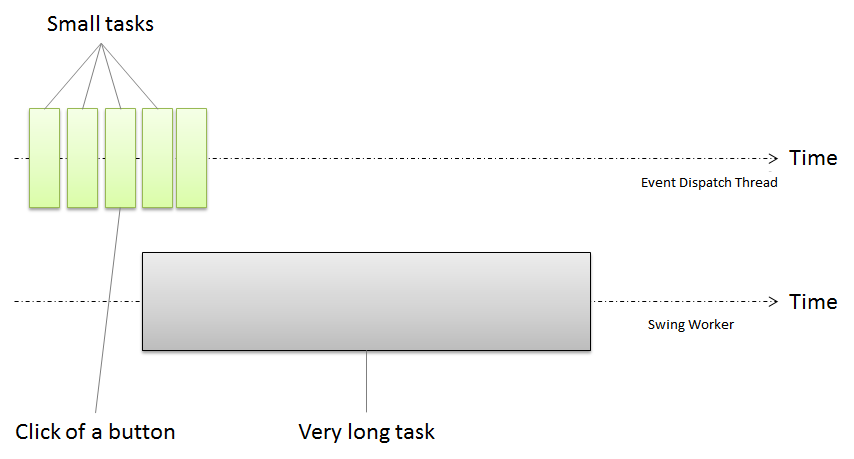Although replacing the EventQueue is a right approach, it's not really necessary since built-in EventQueue already supports prioritizing. Only thing is it only supports it for inner API use so we only need to understand how that works;
//from EventQueue.java...
private static final int LOW_PRIORITY = 0;
private static final int NORM_PRIORITY = 1;
private static final int HIGH_PRIORITY = 2;
private static final int ULTIMATE_PRIORITY = 3;
private static final int NUM_PRIORITIES = ULTIMATE_PRIORITY + 1;
/*
* We maintain one Queue for each priority that the EventQueue supports.
* That is, the EventQueue object is actually implemented as
* NUM_PRIORITIES queues and all Events on a particular internal Queue
* have identical priority. Events are pulled off the EventQueue starting
* with the Queue of highest priority. We progress in decreasing order
* across all Queues.
*/
private Queue[] queues = new Queue[NUM_PRIORITIES];
//...skipped some parts...
/**
* Causes <code>runnable</code> to have its <code>run</code>
* method called in the {@link #isDispatchThread dispatch thread} of
* {@link Toolkit#getSystemEventQueue the system EventQueue}.
* This will happen after all pending events are processed.
*
* @param runnable the <code>Runnable</code> whose <code>run</code>
* method should be executed
* asynchronously in the
* {@link #isDispatchThread event dispatch thread}
* of {@link Toolkit#getSystemEventQueue the system EventQueue}
* @see #invokeAndWait
* @see Toolkit#getSystemEventQueue
* @see #isDispatchThread
* @since 1.2
*/
public static void invokeLater(Runnable runnable) {
Toolkit.getEventQueue().postEvent(
new InvocationEvent(Toolkit.getDefaultToolkit(), runnable));
}
/**
* Posts a 1.1-style event to the <code>EventQueue</code>.
* If there is an existing event on the queue with the same ID
* and event source, the source <code>Component</code>'s
* <code>coalesceEvents</code> method will be called.
*
* @param theEvent an instance of <code>java.awt.AWTEvent</code>,
* or a subclass of it
* @throws NullPointerException if <code>theEvent</code> is <code>null</code>
*/
public void postEvent(AWTEvent theEvent) {
SunToolkit.flushPendingEvents(appContext);
postEventPrivate(theEvent);
}
/**
* Posts a 1.1-style event to the <code>EventQueue</code>.
* If there is an existing event on the queue with the same ID
* and event source, the source <code>Component</code>'s
* <code>coalesceEvents</code> method will be called.
*
* @param theEvent an instance of <code>java.awt.AWTEvent</code>,
* or a subclass of it
*/
private final void postEventPrivate(AWTEvent theEvent) {
theEvent.isPosted = true;
pushPopLock.lock();
try {
if (nextQueue != null) {
// Forward the event to the top of EventQueue stack
nextQueue.postEventPrivate(theEvent);
return;
}
if (dispatchThread == null) {
if (theEvent.getSource() == AWTAutoShutdown.getInstance()) {
return;
} else {
initDispatchThread();
}
}
postEvent(theEvent, getPriority(theEvent));
} finally {
pushPopLock.unlock();
}
}
private static int getPriority(AWTEvent theEvent) {
if (theEvent instanceof PeerEvent) {
PeerEvent peerEvent = (PeerEvent)theEvent;
if ((peerEvent.getFlags() & PeerEvent.ULTIMATE_PRIORITY_EVENT) != 0) {
return ULTIMATE_PRIORITY;
}
if ((peerEvent.getFlags() & PeerEvent.PRIORITY_EVENT) != 0) {
return HIGH_PRIORITY;
}
if ((peerEvent.getFlags() & PeerEvent.LOW_PRIORITY_EVENT) != 0) {
return LOW_PRIORITY;
}
}
int id = theEvent.getID();
if ((id >= PaintEvent.PAINT_FIRST) && (id <= PaintEvent.PAINT_LAST)) {
return LOW_PRIORITY;
}
return NORM_PRIORITY;
}
/**
* Posts the event to the internal Queue of specified priority,
* coalescing as appropriate.
*
* @param theEvent an instance of <code>java.awt.AWTEvent</code>,
* or a subclass of it
* @param priority the desired priority of the event
*/
private void postEvent(AWTEvent theEvent, int priority) {
if (coalesceEvent(theEvent, priority)) {
return;
}
EventQueueItem newItem = new EventQueueItem(theEvent);
cacheEQItem(newItem);
boolean notifyID = (theEvent.getID() == this.waitForID);
if (queues[priority].head == null) {
boolean shouldNotify = noEvents();
queues[priority].head = queues[priority].tail = newItem;
if (shouldNotify) {
if (theEvent.getSource() != AWTAutoShutdown.getInstance()) {
AWTAutoShutdown.getInstance().notifyThreadBusy(dispatchThread);
}
pushPopCond.signalAll();
} else if (notifyID) {
pushPopCond.signalAll();
}
} else {
// The event was not coalesced or has non-Component source.
// Insert it at the end of the appropriate Queue.
queues[priority].tail.next = newItem;
queues[priority].tail = newItem;
if (notifyID) {
pushPopCond.signalAll();
}
}
}
As you can see EventQueue have 4 different queues as LOW, NORM, HIGH and ULTIMATE, SwingUtilities.invokeLater(Runnable) or EventQueue.invokeLater(Runnable) wraps your Runnable into an InvocationEvent and calls postEvent(AWTEvent) method. This method does some syncronizing between threads and calls postEvent(AWTEvent, int) like this postEvent(theEvent, getPriority(theEvent)); Now the interesting part is how getPriority(AWTEvent) works, basicly it gives normal priority to the every event except some PaintEvents and PeerEvents.
So what you need to do is wrap your Runnable into a PeerEvent with ULTIMATE_PRIORTY instead of a InvocationEvent like this;
Toolkit.getDefaultToolkit().getSystemEventQueue()
.postEvent(new PeerEvent(Toolkit.getDefaultToolkit(), () -> {
//execute your high priority task here!
System.out.println("I'm ultimate prioritized in EventQueue!");
}, PeerEvent.ULTIMATE_PRIORITY_EVENT));
You can check the full source code of EventQueue and PeerEvent .
 The events should be executed in Event Dispatch thread and you have a special event which you want to be executed before other events existing in Event Dispatch Thread queue. But, events will be enqueued to the end of the queue by default and even
The events should be executed in Event Dispatch thread and you have a special event which you want to be executed before other events existing in Event Dispatch Thread queue. But, events will be enqueued to the end of the queue by default and even 


SwingWorkerinstances like this. – NarrativeInvokeLaterandInvokeAndWaitis used for the new event respect to the thread it was called. – Mcphail